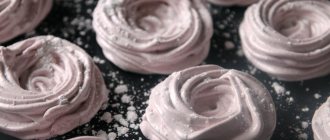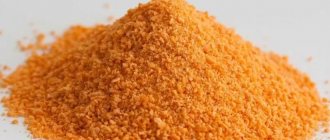The shelf life of natural butter depends on its storage conditions. The product, made from cream and containing no preservatives, can be stored for up to 1.5 months. The addition of chemical components helps extend this period to six months. The taste, freshness and smell of a salty product lasts longer than a sweet and creamy product. The most important factor is temperature - it should not exceed + 5 °C.
How to choose a fresh product
The freshness of butter depends on the conditions of its transportation and storage at points of sale. In large retail chains equipped with modern refrigeration units, it is enough to check the production date indicated on the package.
In large stores, the storage of perishable products is strictly monitored. You should be much more careful when buying oil in small retail kiosks or at the market. To avoid purchasing a product that can cause food poisoning, you must:
- Find the manufacturing date and expiration date on the packaging. You should not buy a product if more than half of the expiration date has passed.
- Open the foil, parchment or other packaging slightly and look at the color of the product - it should be white or light yellow. A bright yellow color indicates that the product is old and bacteria are actively multiplying in it. A deep yellow color may indicate excessive doses of dye.
- Check what the oil smells like - fresh oil has a milky, creamy smell. When stored in a warm place or past the expiration date, it becomes musty.
- When buying a product by weight, you need to try a piece. A rancid taste indicates spoilage of the oil.
If GOST is not indicated on the pack, or there are no numbers after the abbreviation “GOST”, it is a surrogate, a spread. The use of the words “butter”, “country”, “homemade” in the name and a shelf life of more than 90 days indicate an unnatural product - chemical components or vegetable fats have been added to it.
GOST requirements
In GOST 32261-2013 “Butter. Technical Specifications" you can find information about what quality the product should be, under what conditions it should be stored and transported. As stated in the document, shelf life varies depending on the composition, type of packaging and temperature.
Standard portioned pieces in foil packaging according to GOST are stored for up to 15 days at a temperature of 2 to 5 degrees above zero - such conditions are maintained by refrigerators. The product is stored wrapped in parchment for the same amount of time. As for the freezer, when the temperature drops to minus 18 degrees, the shelf life increases to 120 days, provided there is packaging made of foil, parchment or polymer materials.
Oil storage packaging
There are 4 types of packaging in which butter is kept in the refrigerator. Each has its own distinctive features, including the shelf life of the products stored inside, pros and cons:
- The manufacturer's packaging is the most reliable for preserving the taste and beneficial properties. The most popular material is foil. If you have purchased a lot of oil, then it is better not to transfer it from the original packaging, but to keep it in it until use. In sealed plastic containers, the shelf life reaches 1.5 months.
- Oil can. The best materials are glass, porcelain and stainless steel. The container should have a tight lid and opaque walls. Under such conditions, the oil will retain its taste and freshness for up to 15 days. After using each portion, the oiler should be thoroughly rinsed to get rid of germs.
- Foil. To prevent the delicate taste from spoiling and the aroma from disappearing, the butter is wrapped in foil. This way the beneficial properties last for up to 20 days. Disadvantage: the material breaks easily, requires winding in several layers, which is not very convenient for everyday use.
- In parchment paper. The advantage of the material is breathability, due to which the product does not become moldy. Minus - parchment allows air to pass through, oil quickly absorbs the odors of surrounding products. The shelf life is limited to 10 days.
The loose butter is cut into small portions, each is wrapped in foil or parchment, and placed in the refrigerator or freezer. Take out the required pieces as needed.
Margarine stores well in its original packaging. If it has been opened, then the product is not transferred, but wrapped on top with parchment or foil. This will help prevent foreign odors from permeating.
Where and how else you can: storage methods
In fact, there are not many ways to store butter. They are usually divided into two ways:
- in the refrigerator (can be divided into storage in the freezer and in a regular refrigerator);
- at room temperature (i.e. not in the refrigerator).
Each of these methods has a lot of nuances that should not be forgotten so as not to spoil the dairy product.
Refrigerator or freezer
The following describes how to properly preserve the product in the refrigerator and freezer and what storage conditions must be observed. It has already been said that in most cases it is recommended to freeze butter in the freezer to extend its shelf life and preserve all its taste characteristics.
The product must be stored in parchment paper or foil covered with a plastic bag on top. If the temperature in the freezer compartment is −12 degrees, this means that the oil will “live” there for no longer than 9 months. If the temperature tends to −18 degrees, then the shelf life of the oil increases to a year.
As for storage in a regular refrigerator (i.e., without freezing), the same packaging rules apply as for the freezer.
Be sure to store butter in foil, a special butter dish, or a plastic container. The ambient temperature should be 0…+6 degrees. If all rules are followed, the oil will retain all its properties for 3-4 weeks.
At room temperature without refrigeration
Storage without refrigeration devices is relevant for those who like to frequently travel outdoors or spend time traveling. Even in the summer heat, it is possible to store butter without compromising its quality. The average shelf life if all techniques are followed is 21 days.
Here are a few tricks to help you keep your butter delicious and fresh, even without refrigeration.
Brine
- Cut the butter bar into portions and wrap each piece in foil or parchment paper.
- Place all portions in a saucepan and fill with cold salted water (for each liter of water there should be 20 g of table salt).
- Close the pan with a lid and place some heavy press on top.
It is better to store salted butter in a cool, dark place. The old salt solution must be drained and refilled with fresh one regularly .
About storing oil in saline solution in the video:
Soaking in vinegar
- Soak a piece of gauze or any other clean white cloth with vinegar.
- Wrap the butter in this cloth and place it in a food container with a tight lid.
- Put 2-3 cubes of refined sugar there.
Melted butter
- Cut the butter stick into small portions, place them in an aluminum pan (you can use a steel container with a thick bottom) and place on low heat.
- Be sure to remove any foam that appears and continue melting the butter until it becomes literally transparent.
- Cool the finished mass and pour it into a clean, slightly warmed jar (leave the milk protein sediment at the bottom of the pan - this will not be needed) and close the jar with a lid.
This composition can be stored at room temperature away from sunlight for a long time.
Proper storage of butter will not only help preserve its taste, but will also protect you and your family from severe food poisoning. If you suddenly have the slightest suspicion that the product has gone bad, then immediately throw it in the trash and don’t take any risks.
It is best, of course, to store the product in the freezer or refrigerator and use life hacks that allow you to store oil outside the refrigeration device as rarely as possible.
In the video about preparing and storing ghee:
How long can butter be stored in the refrigerator?
The shelf life of butter in the refrigerator depends on several factors. The lower the temperature, the longer the product will retain its properties; optimal indicators range from 0 to +5 °C. Humidity should not exceed 75% - mold will form on the surface if damp.
Margarine can be kept in the refrigerator for up to 3 months at temperatures up to +8 ° C, the integrity of the packaging does not affect its shelf life.
Shelf life of natural butter according to GOST 32261-2013, depending on air temperature and packaging (in days):
| Temperature, °C | Parchment | Foil | Sealed factory containers |
| from 0 to +5 | 10 | 45 | 120 |
| -2-9 | 20 | 60 | 120 |
| -15-18 | 45 | 75 | 120 |
The benefits and harms of butter
A historically valuable and useful product began to lose popularity in the second half of the 20th century. The high content of saturated fats has made butter an unhealthy food. After discovering easily digestible fatty acids in the composition, expert opinions were divided.
In recent years, butter has begun to be classified as a food that increases “good” cholesterol. The body needs a fat-like substance in a certain amount; the production of hormones and the proper formation of new cells depend on it.
Composition and beneficial properties
The beneficial properties of the product are determined by its composition:
- Vitamin A. Maintains visual acuity, functions of the endocrine system, improves the condition of hair and skin.
- Vitamins: D, E, K. Participate in redox processes, metabolism of proteins, fats, carbohydrates, electrolytes.
- Selenium. A powerful antioxidant removes toxins and free radicals from the body.
- Iodine. Normalizes the activity of the thyroid gland.
- Butyric acid. Nourishes and stimulates the intestines. Has anti-carcinogenic properties.
- Lauric acid. Has antibacterial and antifungal properties. Prevents the occurrence of cancer.
- Fatty acid. Supports the human reproductive system.
- Oleic acid. Normalizes cholesterol in the blood, starts metabolism and fat metabolism, fights cancer cells.
Butter contains large quantities of lipids, including glycerides. Due to their oxidation, about 50% of the energy needs of the adult human body are covered. Among the fatty acids in the composition are glycosphingolipids, which protect the intestines from infections.
Important! Moderate consumption of butter does not cause excess weight. The fatty acids included in the composition are spent only on energy supply. After consuming 20 g of oil, the feeling of hunger disappears.
Add butter to green tea and milk (1 tsp per glass). Warm drinking relieves coughs, serves as a restorative after pneumonia, and strengthens the immune system.
Butter (1 tsp) before drinking alcohol reduces the risk of rapid entry into the blood. The oil coats the gastric mucosa and reduces the metabolism of alcohol.
Harmful properties and contraindications
In large quantities, the product harms even healthy people. To ensure that the beneficial properties do not turn into harmful ones, it is not recommended to exceed the daily intake:
- 20–30 g for adults;
- 10–20 g for teenagers;
- 5–10 g for children.
What happens if you exceed the norm:
Deterioration of skin condition.- With a slight metabolic disorder, a large amount of consumed fat provokes improper functioning of the sebaceous glands, resulting in oily sheen, pimples and blackheads.
- Overweight.
- Depending on the type, the product contains from 65% to 82.5% fat. With frequent and uncontrolled consumption of oil, subcutaneous deposits accumulate.
- Increased cholesterol levels.
The accumulation of beneficial cholesterol occurs when consuming the daily norm. If the blood level is exceeded, you should completely discard the oil.
Take with caution in case of chronic diseases of the cardiovascular system and gastrointestinal tract.
To ensure that butter does not lose its taste, aroma and beneficial properties, it is necessary to comply with the required storage conditions.
How to store butter in the freezer
Like most high-fat foods, butter can be stored in the freezer; it tolerates low temperatures well. It should be cut into small pieces, each wrapped in a separate piece of parchment or foil and placed in a bag. It is better to use the freezer shelf without foods with a strong smell. Suitable temperature is -18 °C and below.
You need to take out pieces as needed. After defrosting, fat content and other characteristics are completely preserved. In the freezer, the shelf life reaches 6 months without loss of quality. Repeated freezing is undesirable, but acceptable. You should not defrost the product more than 3 times - its structure will be disrupted, vitamins and other useful substances will disintegrate.
Margarine can be kept in the freezer at -12-18 °C for up to a year. It tolerates re-freezing better due to the vegetable fats in the composition.
Butter or spread – how to tell the difference?
Not every buyer knows the difference between an oil-like product and butter. Some do not notice the differences, others tend to consider the spread a “low-fat” creamy product. What is it really?
The basis for making butter is cream. Normalized milk in special production separators is divided into skim milk and high-fat cream. Next, the latter are whipped using oil presses, resulting in the formation of oil. Everything in it is natural - if food additives are included in the composition, then in extremely small quantities.
May additionally include:
- natural dye carotene (no more than 3 mg/kg) for color;
- vitamin preservatives (vitamin A no more than 10 ml/kg);
- vegetable dye annatto (not more than 10 mg/kg);
- bacterial starter;
- salt;
- drinking water.
Do you know that…
Butter can be called a product made from cream with a fat content of at least 72.5%. Products containing other components are automatically classified as spreads and margarines. This product is cheaper than the real thing.
The spread is based on 2 parts:
- Dairy: cream, milk, buttermilk.
- Vegetable: corn, sunflower, olive, coconut, palm and other types of oil.
By carefully studying the composition, you can understand whether it is a spread or an oil. Also, natural cream products have GOST R-52969. If there are different numbers on the packaging, this is a vegetable fat product or margarine, which are manufactured according to other GOST standards, which allow the inclusion of flavors, preservatives, and emulsifiers. Thanks to this, the shelf life of the spread can reach up to 100 days.
Since 2014, GOST has been introduced for an independent product - butter with fillers: chocolate, honey, herbs, seafood and meat products, berries, fruits, vegetables and their mixtures
The following ways to independently distinguish spread from butter are popular among housewives:
- Place in the freezer, after 10 minutes take it out and cut a piece of paper. If the product crumbles, then it is a quality product; if not, then this is a sign of a spread.
- Natural butter has a characteristic pleasant smell and a dull yellow color. Yellow and orange indicate the presence of dyes. To detect them for sure, you need to put a piece in 40% alcohol. Coloring of the liquid indicates the presence of dyes.
- Heat up the speed and add the product. The butter will quickly melt and sizzle, and a pleasant smell will be heard. The spread will gradually begin to melt, and the resulting “aroma” will cause the need to ventilate the kitchen.
But these methods are not always justified.
Expert comment:
“Manufacturers of oil substitutes and spreads are constantly improving technology. I have been identifying falsified oils in the laboratory for many years, but even I cannot determine the falsification at home.”
How to store butter without refrigeration
The product can be stored in a warm room for no more than 48 hours. Folk ways to preserve butter without refrigeration for a long time:
- A jar of cool water. Cut the butter into pieces or bars and place in water. Place in the coolest dark place possible. Change the water at least 2-3 times a day to cold water. This way you can save the oil for up to 7 days.
- Water with salt. For 1 liter of liquid – 1 tbsp. l. substances with a slide. The product is wrapped in small pieces in parchment, placed in a pan and filled with salted water. You need to put pressure on top. Storage period – up to 10 days. If you change the salt water daily, this period is up to 20 days.
- Table vinegar solution (5%). The butter sticks are placed in a glass jar, filled with solution, and tightly closed with a lid. The jar is placed in a cool, dark place. Shelf life – up to 21 days.
Butter with vegetable additives is stored at room temperature for up to 10 days, margarine for up to 3 weeks.
Basic storage modes
For storing a product with a standard fat content of 82.5%, three main modes are recommended. As a rule, they are included in the packaging by the manufacturer.
Mode 1
Provided at temperatures from -14°C to -18°C with a relative air humidity of no more than 90%. Conditions include storing the product in a freezer or outdoors during the winter with low temperatures. Conditions ensure maximum shelf life: up to 4 months.
Mode 2
Created at higher temperatures: -4°C to -8°C and relative humidity up to 90%. Corresponds to storage conditions in the freezer and outdoors, subject to the necessary compliance with the threshold humidity values. The shelf life of the product is up to 2 months.
Mode 3
The acceptable mode in which the oil remains soft is in the temperature range from +1°C to +5°C and a relative humidity of no more than 90%. Corresponds to the operating parameters of the refrigeration chamber. The product remains fresh for up to 7 days.
Signs of a spoiled product
You can tell that butter or margarine has begun to spoil by the following signs:
- the color changes to bright yellow, greenish or dirty yellow;
- the taste becomes bitter;
- the smell is musty, putrid.
These changes indicate the development of pathogenic microflora in the product. Its consumption is dangerous to health - it is possible to develop food poisoning in mild, moderate or severe form.
If the product’s expiration date has passed, but there are no signs of spoilage, then it is put into baked goods or added to pet food.
Storage conditions
As is known, oxidation processes begin in this product from sunlight and positive temperatures, beneficial substances are destroyed, and its taste deteriorates. It also has the ability to absorb odors. Therefore, it is necessary to create suitable storage conditions for butter.
- Both polyethylene and cling film provide virtually no protection from light and air, which lead to the proliferation of pathogenic bacteria in the product. But you can safely store it in foil or parchment paper packaging. Weighted oil must be packaged in one of these materials.
- The oil dish, although it is convenient, must be chosen meticulously. The best option is opaque, closed, and the tighter the lid is closed, the better. The most suitable materials for this cookware are porcelain, ceramics, stainless steel or high-quality food-grade plastic. It is wrong to use a clear glass oil dish - it does not protect from light. Plastic dishes absorb refrigerator odors, so they also do not meet the requirements for proper storage.
You also need to store butter in the freezer wisely.
- It should be cut into small pieces - this way you can avoid repeated defrosting.
- Then each of them is wrapped in parchment or laminated foil, placed either in a container or in a strong plastic bag and carefully closed. This way he is not afraid of freezer odors.
Resuscitation of spoiled oil
It is better to throw away spoiled oil. If you decide to use it, you can try to eliminate the unpleasant odor and bitter taste in the following ways:
- Make a solution of baking soda - 1 tsp. 200 ml of cool water, pour oil for 30 minutes. Drain the solution, melt the product, adding 2 tbsp. l. milk. Refrigerate to harden.
- Wash off plaque from the surface with running water. Season with salt and sprinkle with carrot juice.
- Melt, add a piece of white bread or a slice of green apple. Cool, refrigerate.
- Place in milk so that the liquid completely covers the piece, knead, and leave for an hour. Rinse with water.
These methods help improve the characteristics of the product, but it is advisable to use it only for baking. Heat treatment will destroy pathogenic microorganisms.
Butter requires compliance with storage conditions - it must be kept in the cold. The product tolerates freezing well, completely restoring its original properties after thawing. You should not buy many packs at once; it is better to purchase as needed. The exception is cases of residence remote from shops in villages and villages.
What kind of butter do you buy - natural or with vegetable additives? Do you use a freezer for storage? Share the article with friends and acquaintances, save it on your page on social networks.
You have 2 correct solutions:
- If the oil packaging material has a transparent or translucent base, put the oil in an oil dish with an opaque lid. If you don’t have a butter dish, then wrap it in foil, this way it will be stored longer than in parchment, and the taste will not deteriorate, as if stored in a plastic bag. We advise you to make sure that there are no strong-smelling products nearby, so the oil quickly absorbs foreign odors.
- Otherwise, when the base is lightproof, store the butter in the refrigerator in its original wrapper. Typically, an opaque wrap is a bonding of foil to laminated paper. This helps prevent spoilage from exposure to light and air, and also protects the oil from absorbing odors and flavors from other foods.
Both salted and unsalted butter will keep well in the refrigerator for 3 weeks. If you plan to extend the period beyond 3 weeks, the product will retain its fresh taste better if you change the packaging material or transfer it to a new plastic container or clean plastic container.
The properties of the oil allow it to harden well. Additionally, you can improve the protection of the oil from temperature and external influences - simply wrap the product in an additional shell, heavy-duty plastic film or a tightly closed bag.
Properly wrapped salted butter will keep well in the freezer for up to one year.
. After this, it may begin to lose its fresh, creamy taste and pick up other smells or aromas from the freezer. Unsalted butter will keep in the freezer for up to three months.
When purchasing a product, immediately pay attention to the shelf life
.
Moreover, by the time you purchase the oil, the oil has been in the store for several days. If you buy packaged butter in parchment or foil, the expiration date should be indicated on the packaging. As a rule, portioned butter is stored in parchment paper for 10 days
, in foil -
20 days
.











